The remote patient monitoring devices market is estimated to be valued at USD 14.34 Bn in 2025 and is expected to reach USD 40.30 Bn by 2032, growing at a compound annual growth rate (CAGR) of 15.9% from 2025 to 2032.
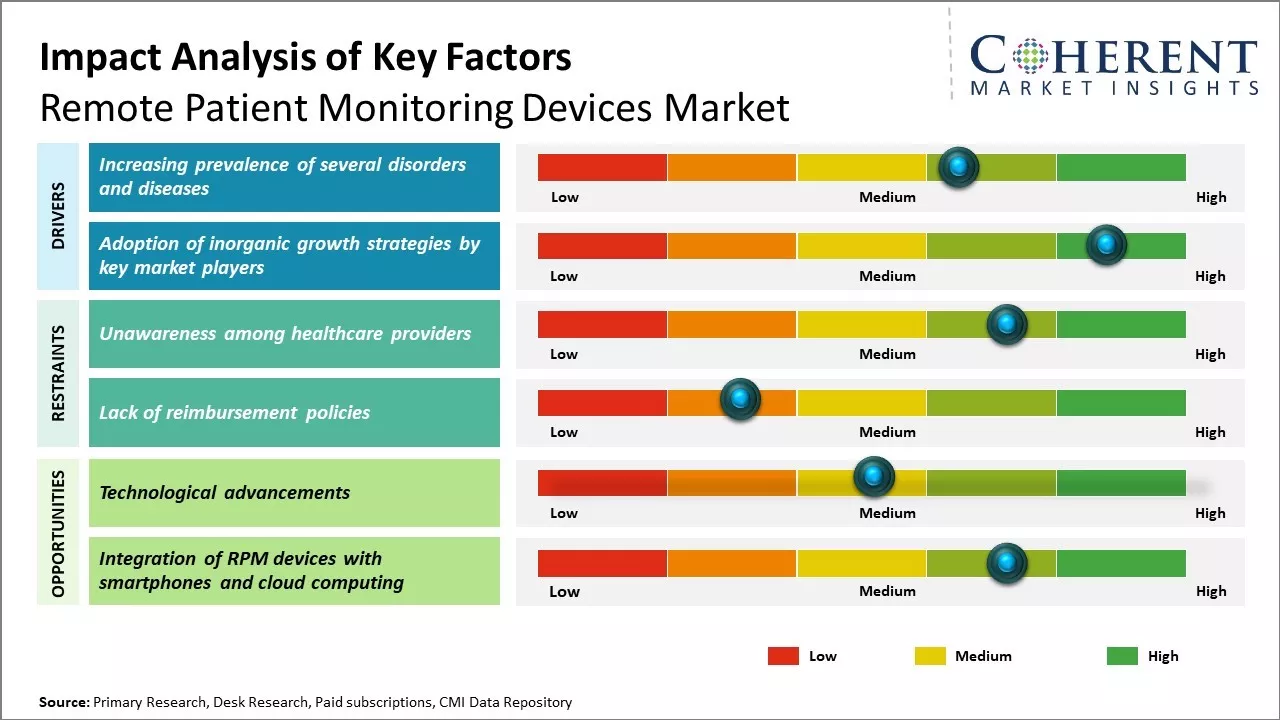
Discover market dynamics shaping the industry: Request sample copy
The market is expected to witness strong growth during the forecast period due to the rising geriatric population, growing prevalence of chronic diseases, and increasing need for cost-effective healthcare delivery. Remote patient monitoring enables remote tracking of vital signs and ensures early detection of adverse health conditions in at-risk patients. This helps in improving health outcomes, reducing healthcare costs, and managing chronic conditions effectively without hospital visits or professional healthcare assistance. Therefore, with its benefits of enhanced patient care and cost savings, the demand for remote patient monitoring devices is projected to increase significantly over the next few years.
Increasing prevalence of several disorders and diseases
The global remote patient monitoring devices market is expected to witness significant growth over the forecast period, owing to the increasing prevalence of disorders such as cardiac disorders, respiratory disorders, and others. According to the World Health Organization (WHO) report published in June 2021, an estimated 17.9 million people died from cardiovascular diseases in 2019, representing 32% of all global deaths, out of these deaths, 85% were due to heart attack and stroke globally. Out of the 17 million premature deaths (under the age of 70) due to non-communicable diseases in 2019, 38% were caused by cardiovascular diseases globally.
Moreover, according to the same source, on May 20, 2022, nearly 90% of chronic obstructive pulmonary disease (COPD) deaths globally in those under 70 years of age occur in low- and middle-income countries (LMIC) like India and Bangladesh. Therefore, the high prevalence of diabetes and chronic obstructive pulmonary disease worldwide is expected to drive the global remote patient monitoring devices market growth over the forecast period.
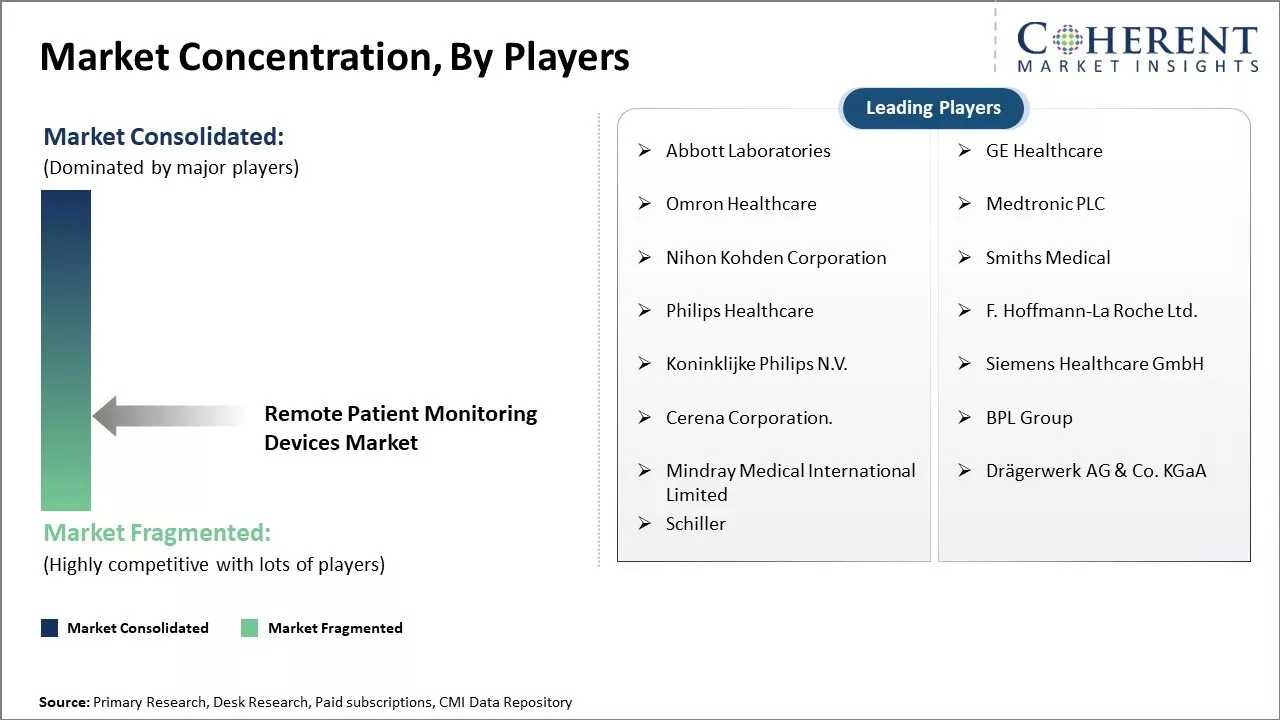
Get actionable strategies to beat competition: Request sample copy
Adoption of inorganic growth strategies by key market playersKey players are focused on adopting inorganic growth strategies, such as collaborations, which is expected to drive the global remote patient monitoring devices market growth. For instance, in October 2022, GE Healthcare, a medical technology company, and AMC Health, a provider of remote patient monitoring services, announced a collaboration that will enable clinicians to offer Remote Patient Monitoring (RPM) as a virtual care solution that extends patient care beyond the hospital to the home environment. The combination of GE Healthcare's acute patient monitoring capabilities in the hospital setting and AMC Health's expertise in RPM solutions using an U.S. FDA Class II 510(k)-cleared platform with analytics will broaden the continuum of non-acute care for patients after they are discharged from the hospital.
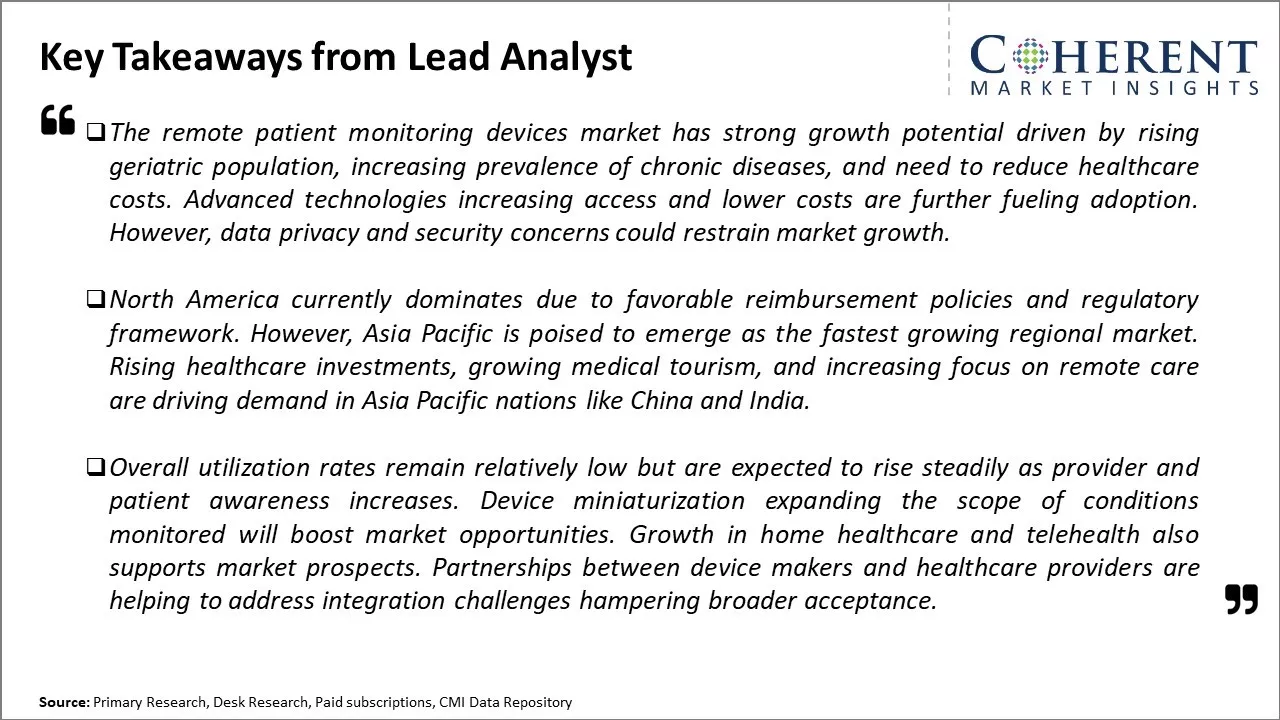
To learn more about this report, Request sample copy
Market Challenges: Unawareness among healthcare providersThe remote patient monitoring devices market faces several challenges. Healthcare providers have been slow to adopt remote monitoring technologies due to concerns around data security and reimbursement structure. Many patients also do not feel comfortable with the idea of remote care and monitoring. Additionally, the upfront investment required for deploying remote monitoring solutions poses a barrier for healthcare systems.
Market Opportunities: Technological advancements
With growing prevalence of chronic conditions and push for self-care, remote monitoring allows improved management of health outside of clinical settings. Aging population globally will drive the need for independent living and remote care solutions. Technological advancements are addressing challenges around data security and usability of remote devices. This could help drive greater provider and patient acceptance of remote monitoring over time.
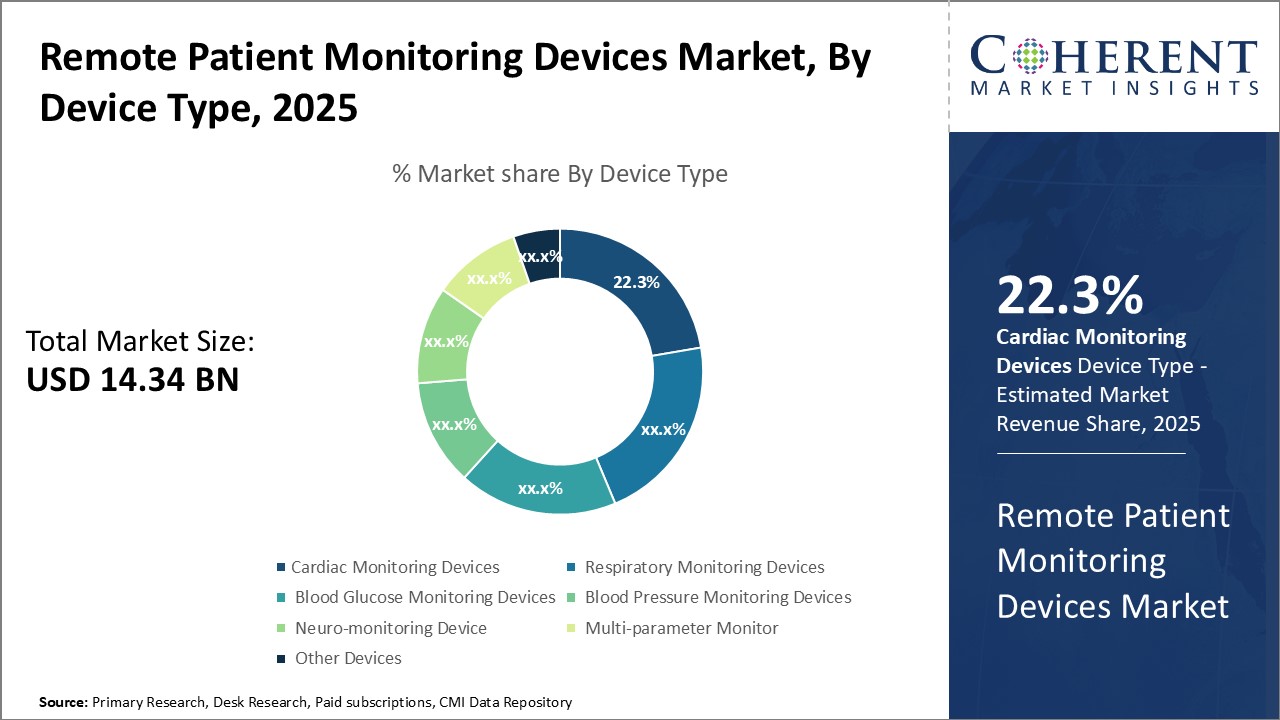
Discover high revenue pocket segments and roadmap to it: Request sample copy
Insights, By Device Type: Convenience and increased accessibility drive the growth of blood glucose monitoring devicesThe device type segment includes cardiac monitoring devices, respiratory monitoring devices, blood glucose monitoring devices, blood pressure monitoring devices, neuro-monitoring device, multi-parameter monitor, and other devices. Blood glucose monitoring devices is anticipated to hold 22.3% of the market share in 2025. Patients with diabetes need to monitor their blood glucose levels several times a day to ensure proper management of the disease. Traditional fingerstick methods are time consuming and cause pain and discomfort during each test. In contrast, Blood Glucose Monitoring Devices allow patients to easily check their glucose levels with just a small blood sample from a finger-prick. This reduces the burden and hassle of monitoring for patients. Additionally, these devices offer increased accessibility to monitoring. Results are displayed digitally, allowing patients to check their levels anywhere and anytime without needing to visit a lab. The recorded data can also be transferred to physicians or caregivers remotely for improved treatment management.
Insights, By Application: Increased incidence of chronic diseases drives growth in diabetes applications
The application segment includes oncology, cardiology, hypertension, chronic respiratory diseases, neurology, diabetes, and others. Diabetes contributes the highest share of the remote patient monitoring devices market and is projected to hold 27.3% of the market share in 2025. Diabetes currently affects over 420 million people globally and this number is projected to increase significantly in the coming decades. Developing regions will bear most of this rise due to lifestyle changes, urbanization and growing geriatric populations. Poorly managed diabetes greatly increases the risk of heart disease, stroke, blindness, kidney failure, and lower-limb amputations. Remote patient monitoring devices play a vital role in managing diabetes by helping patients track important parameters like blood glucose, blood pressure, weight etc. Regular monitoring helps physicians optimize medication schedules and catch abnormalities early to prevent complications. It provides an alternative to frequently visiting hospitals for check-ups, thereby improving access and adherence to treatment. This is of particular use in rural areas where specialized diabetes care services may not be conveniently available. Telehealth consults using monitoring data allow physicians to continue supervision of chronic cases from a distance.
Insights, By End User: Convenience and cost advantages drives home healthcare adoption
The end user segment includes home healthcare settings, hospitals & clinics, ambulatory care centers, and others. Home healthcare settings contribute the highest share of the remote patient monitoring devices market and is projected to hold 32.7% of the market share in 2025. Remote patient monitoring allows high-risk and chronic illness patients to receive medical care and supervision while resting comfortably at home. This reduces patient travel for routine check-ups, decreases waiting times at facilities and improves access for disabled individuals. Remote monitoring helps extend supportive hospital-level care into the home setting, expediting discharge, and preventing readmissions for recovering patients. Home use of monitoring devices also lowers the economic burden on patients and the overall healthcare system through avoided facility visits.
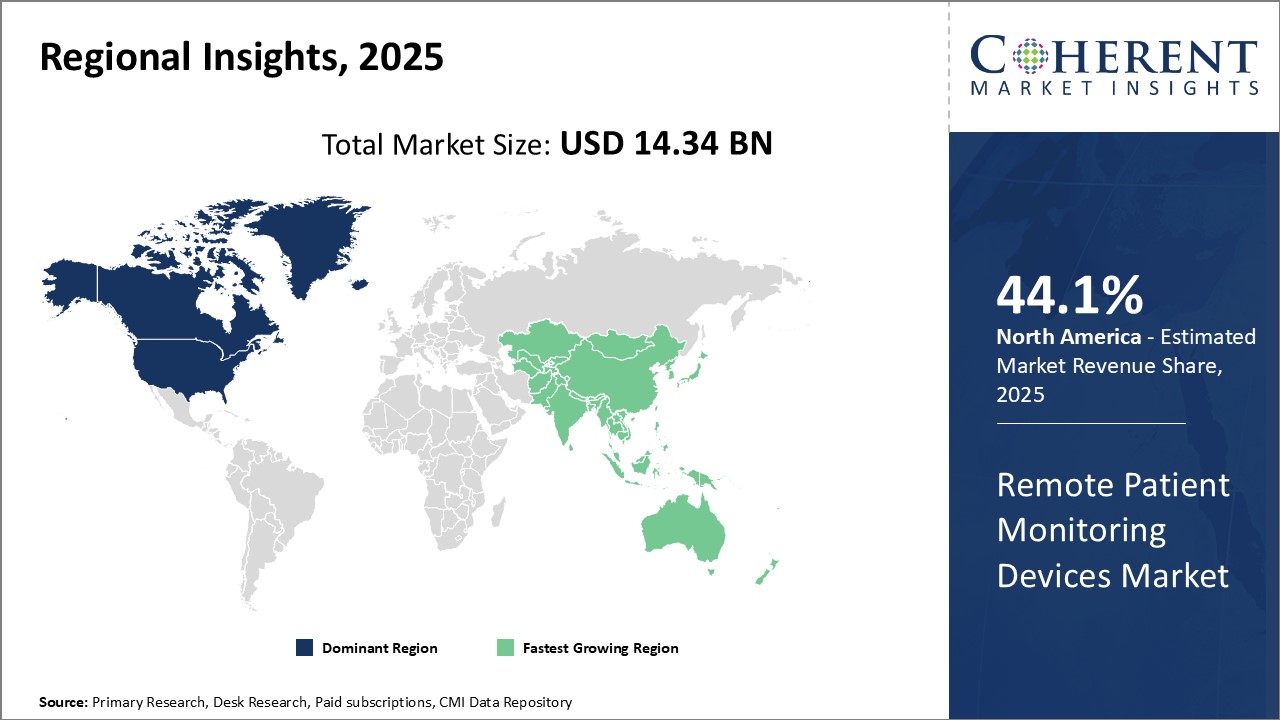
Need a Different Region or Segment? Customize now
North America dominates the global remote patient monitoring devices market currently due to a strong healthcare infrastructure and rising prevalence of chronic diseases in the region and is anticipated to hold 44.1% of the market share in 2025. The U.S. accounts for the largest share mainly because of the growing need to reduce healthcare costs and increasing insurance coverage in the country. Many leading players operating in remote patient monitoring devices market such as Medtronic, Philips, and GE Healthcare have their headquarters in the U.S., giving North America an edge in terms of technology availability and product innovation. Besides, favorable regulatory environment and reimbursement policies have ensured wider adoption of remote monitoring solutions in the region over the past few years.
Asia Pacific is poised to be the fastest growing market for remote patient monitoring devices globally over the next few years. Countries like China, India, Japan, and South Korea are expected to offer the highest growth potential owing to the rapidly expanding medical technologies industry, growing healthcare expenditure, and increasing patient awareness levels. Additionally, rising geriatric population suffering from chronic illnesses, improving accessibility of Internet-based telehealth solutions, and supportive government policies aimed at modernizing the healthcare infrastructure are further fueling the market growth. Several global companies have also started establishing manufacturing facilities or engaging in partnerships with regional MedTech players to tap into opportunities in the Asia Pacific region.
Remote Patient Monitoring Devices Market Report Coverage
| Report Coverage | Details | ||
|---|---|---|---|
| Base Year: | 2024 | Market Size in 2025: | USD 14.34 Bn |
| Historical Data for: | 2020 To 2024 | Forecast Period: | 2025 To 2032 |
| Forecast Period 2025 to 2032 CAGR: | 15.9% | 2032 Value Projection: | USD 40.30 Bn |
| Geographies covered: |
|
||
| Segments covered: |
|
||
| Companies covered: |
Abbott Laboratories, GE Healthcare, Omron Healthcare, Medtronic PLC, Nihon Kohden Corporation, Smiths Medical, Philips Healthcare, F. Hoffmann-La Roche Ltd., Koninklijke Philips N.V., Siemens Healthcare GmbH, Cerena Corporation., BPL Group, Mindray Medical International Limited, Drägerwerk AG & Co. KGaA, and Schiller |
||
| Growth Drivers: |
|
||
| Restraints & Challenges: |
|
||
Uncover macros and micros vetted on 75+ parameters: Get instant access to report
Share
Share
About Author
Komal Dighe is a Management Consultant with over 8 years of experience in market research and consulting. She excels in managing and delivering high-quality insights and solutions in Health-tech Consulting reports. Her expertise encompasses conducting both primary and secondary research, effectively addressing client requirements, and excelling in market estimation and forecast. Her comprehensive approach ensures that clients receive thorough and accurate analyses, enabling them to make informed decisions and capitalize on market opportunities.
Missing comfort of reading report in your local language? Find your preferred language :
Transform your Strategy with Exclusive Trending Reports :
Frequently Asked Questions
Joining thousands of companies around the world committed to making the Excellent Business Solutions.
View All Our Clients
US Reciprocal Tax Impact Analysis On Remote Patient Monitoring Devices Market
Stay updated on tariff changes with expert insights and timely information